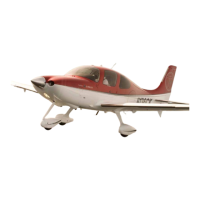10-6 P/N 13772-003
Section 10 Cirrus Design
Safety Information SR22T
General Deployment Information
Deployment Speed
The maximum speed at which deployment has been demonstrated is
133 KIAS. Deployment at higher speeds could subject the parachute
and aircraft to excessive loads that could result in structural failure.
Once a decision has been made to deploy the CAPS, make all
reasonable efforts to slow to the minimum possible airspeed. However,
if time and altitude are critical, and/or ground impact is imminent, the
CAPS should be activated regardless of airspeed.
Deployment Altitude
No minimum altitude for deployment has been set. This is because the
actual altitude loss during a particular deployment depends upon the
airplane’s airspeed, altitude and attitude at deployment as well as
other environmental factors. In all cases, however, the chances of a
successful deployment increase with altitude. As a guideline, the
demonstrated altitude loss from entry into a one-turn spin until under a
stabilized parachute is 920 feet. Altitude loss from level flight
deployments has been demonstrated at less than 400 feet. With these
numbers in mind it might be useful to keep 2,000 feet AGL in mind as a
cut-off decision altitude. Above 2,000 feet, there would normally be
time to systematically assess and address the aircraft emergency.
Below 2,000 feet, the decision to activate the CAPS has to come
almost immediately in order to maximize the possibility of successful
deployment. At any altitude, once the CAPS is determined to be the
only alternative available for saving the aircraft occupants, deploy the
system without delay.
Deployment Attitude
The CAPS has been tested in all flap configurations at speeds ranging
from V
SO
to V
A
. Most CAPS testing was accomplished from a level
attitude. Deployment from a spin was also tested. From these tests it
was found that as long as the parachute was introduced to the free air
by the rocket, it would successfully recover the aircraft into its level
descent attitude under parachute. However, it can be assumed that to
minimize the chances of parachute entanglement and reduce aircraft
oscillations under the parachute, the CAPS should be activated from a
wings-level, upright attitude if at all possible.
Original Issue

